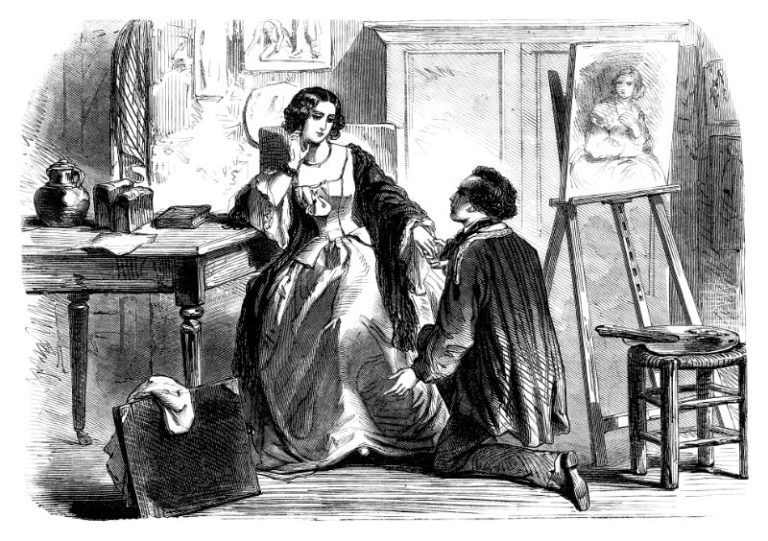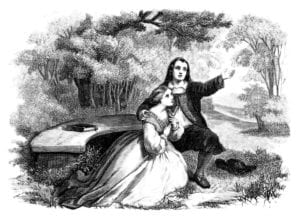The Language of Shakespeare
It is believed that over 1,700 words appear for the first time in Shakespeare’s plays. This does not mean that he invented them, but it does suggest he had a keen ear for language and a genius for inventing at least some words.
But what does language mean to the characters he created? For Mowbray in ‘Richard II’, to be banished from England and abandoned among non-English speakers is to be deprived altogether of the power of speech: ‘What is thy sentence then but speechless death?’ he asks the King on learning his fate.
For Caliban, by contrast, speech is an ambiguous blessing: ‘You taught me language’, he reminds Prospero, ‘and my profit on’t / Is, I know how to curse. The red plague rid you / For learning me your language!’
As ‘The Tempest’ ends, Caliban is abandoned on the island, alone and no longer in need of Prospero’s language.
Betrayal in Shakespeare
Betrayal for power or sex is among Shakespeare’s most prominent themes. When power is the spur, it’s often trusted family members who are to blame: Prospero in ‘The Tempest’ is ousted from his Dukedom by his brother Sebastian, while in ‘As You Like It’, Duke Senior is betrayed by his brother Frederick. Both survive to recover their thrones – in contrast with Hamlet’s father, murdered by his brother Claudius, or Duncan, slain by his ‘kinsman’ Macbeth. Lear, abandoned to his fate by once-trusted daughters, is a further victim.
Sex serves as a second irresistible motive: Proteus, one of the ‘Two Gentlemen of Verona’, attempts a sexual assault on Silvia, the lover of his best friend Valentine; similarly, in ‘Titus Andronicus’, Chiron and Demetrius ravish Lavinia, then mutilate her body in a gruesome sequence. ‘The Rape of Lucrece’, a long poem set in Ancient Rome, explores similar themes. Cressida’s betrayal of Troilus seems modest in comparison.
Finally, there is a handful of betrayals which might be called ‘motiveless’. Most notorious is Iago’s betrayal of Othello: his motives may be power, or sex, or they may be simply the thrill of destruction. Don John’s motives in trying to destroy Hero in ‘Much Ado’ may be just as elusive, while the Queen’s schemes to kill Imogen in ‘Cymbeline’ are equally opaque. Meanwhile, Shakespeare’s most instinctive betrayer, Falstaff, is betrayed in turn by the newly-crowned Prince Hal: ‘I know thee not, old man’.
Praise for Shakespeare (1598)
It seems that Shakespeare succeeded quite quickly in gaining the respect of his fellow authors. Francis Meres’s ‘Palladis Tamia, Wits Treasury’, a survey of contemporary English writing, was published in 1598, and Shakespeare is fulsomely applauded in its pages. Described as ‘mellifluous and hony-tongued’, he is praised initially for his poems: ‘witness his Venus and Adonis’, Meres advises, ‘his Lucrece, his sugred sonnets among his priuate friends, &tc’.
Next his plays are praised, as Shakespeare is applauded for being ‘most excellent in both kinds [of genre, Tragedy and Comedy] for the stage’, and examples are given: ‘Romeo and Juliet’ for instance, and ‘The Merchant of Venice’.
Included in the list of Shakespeare’s plays around halfway through his career, Meres mentions ‘Loue labours wonne’ – apparently a sequel to ‘Love’s Labour’s Lost’ (1594) – as mentioned above (#27). The play is known from other sources to have existed – it is listed in a stationer’s account book in 1603 – but no more is known of this lost play.
Severed Heads in Shakespeare
The severed heads of traitors were a familiar sight in Shakespeare’s England, often adorning city gates as a macabre deterrent for citizens with criminal intentions.
Shakespeare’s plays reflect this punitive convention, with severed heads a common feature. Suffolk has his head cut off in ‘Henry VI Part Two’, whereupon it is sent to the Queen, with whom he is close, while Hastings suffers the same fate in ‘Richard III’.
Similarly, in ‘Richard II’, Bushy and Green are decapitated – ‘their peace is made with heads, / And not with hands’, as Scroop reports. In ‘Measure for Measure’, it is Ragozine’s head that is eventually sent to Angelo as ‘evidence’ that Claudio has been executed, and in ‘Cymbeline’, it is Cloten’s decapitated body that Imogen mistakes for her beloved Posthumus. Finally, the climax of ‘Macbeth’ is marked by Macduff’s arrival with ‘the usurper’s cursed head’ in his possession.
A trip to the Globe Theatre, incidentally, would mean for the majority a walk across London Bridge. Severed heads, impaled on spikes, were a common sight here.
Masculinity in Shakespeare
Was Shakespeare a misanthrope? His representation of the male of the species is hardly flattering. Endlessly quarrelsome, violent and self-destructive, while simultaneously devious and not to be trusted, Shakespeare’s male characters are a rum lot.
Paradoxically, however, their capacity for evil is one of the mainsprings of their appeal: characters like Don John, Richard III and Iago are compelling because they are evil, confiding their plans in an audience as reluctant to listen as they are magnetised. Characters like Coriolanus, Macbeth and Timon of Athens, Sebastian and Antonio in ‘The Tempest’ and Edmund in ‘King Lear’ are all at ease with violence if it serves their purposes.
Meanwhile male deviousness and dishonesty is pervasive: men can’t be trusted. Edward III romances the Countess of Salisbury while her husband is away at the front; the puritanical Angelo, temporarily governor of Vienna in ‘Measure for Measure’, will meet a subject half-way if she’ll sleep with him; Proteus accompanies his best friend’s beloved in ‘Two Gentlemen of Verona’ with the intention of raping her, and is only distracted by chance from his purpose.
The comparison with Shakespeare’s female characters is striking: there are few if any males as admirable as Rosalind in ‘As You Like It’, as resourceful as Portia in ‘The Merchant of Venice’, or as dignified as Olivia in ‘Twelfth Night’.
Shakespeare’s Theatres
Shakespeare’s name is synonymous with The Globe Theatre, where many of his greatest works first saw the light of day. Yet this fabled theatre, built in 1599, did not exist for the first half of Shakespeare’s career as an author.
From 1594, the Lord Chamberlain’s Men performed at The Theatre at Shoreditch – the theatre itself belonged to the company, but the land was not theirs. The company switched to The Curtain Theatre three years later before dismantling their Shoreditch arena beam by beam in 1598 – 9 and carrying it across the river to Southwark. Here they reconstructed it on land bought for the purpose, and called it The Globe.
Meanwhile The Blackfriars theatre was being prepared, ready to enter service in 1608 as an alternative venue. The Globe burned down in 1613 when a cannonball from a production of ‘Henry VIII’ caused the thatched roof to catch fire. It was rebuilt a year later, before being closed by the Puritans in the 1640s.
‘The Passionate Pilgrim’ (1599)
Formal copyright conventions weren’t introduced into British law until 1710. Until then, if a printer wanted to publish a play or poem by a writer he admired, he could go ahead and do it.
Shakespeare was a victim of this wild west approach to publishing when one William Jaggard printed a collection of poems entitled ‘The Passionate Pilgrim by William Shakespeare’ in 1599. In practice, only five of the poems were by Shakespeare, the rest being culled from various other writers.
This story has two post-scripts: when Shakespeare’s 154 sonnets were published a decade later in 1609 – apparently with his permission and direction – the volume was titled ‘William Shakespeare’s Sonnets, Never Before Imprinted’: unmistakeably authentic.
Later still, when John Heminges and Henry Condell assembled the collected plays that became The First Folio (1616), the task of printing the 750 copies was lodged with the printing firm of William and Isaac Jaggard.
Shakespeare’s Clowns and Fools
Many of the early comedies feature characters designed to amuse and delight the audience. Clowns like Launce (‘Two Gentlemen of Verona’, 1590), Costard (‘Love’s Labour’s Lost’, 1594), Bottom (‘A Midsummer Night’s Dream’, 1595) and Gobbo (‘The Merchant of Venice’, 1595) may not always win their battles with the English Language, but they remain endearing even so.
Later plays feature characters richer and more sensitive in their personalities. Detached, thoughtful, cynical, wise – despite their status as Fools – characters like Touchstone in ‘As You Like It’ (1599) and Feste (‘Twelfth Night’, 1599) have a higher status and deeper involvement in the play than the Clowns. The Fool in ‘King Lear’ (1606) is a further case of the wise Fool who speaks truth to power.
Is there an explanation for this change from Clowns to Fools? It may be co-incidence, but the company’s resident clown, the exuberant Will Kemp, left the Lord Chamberlain’s Men in around 1599, to be replaced by the more thoughtful Robert Armin.
Female Characters with Careers
Which careers are open to women in Shakespeare’s plays? Helena in ‘All’s Well’ is a medical expert, trained by her late father: her skills will prove instrumental in saving the life of the King of France. Meanwhile Portia in ‘The Merchant of Venice’ reveals an unexpected legal genius as she unravels the complex knot of Shylock’s contract with Antonio.
Elsewhere, Mistress Quickly manages the Boar’s Head in Cheapside where Falstaff holds court in ‘Henry IV Part Two’, while Emilia is Abbess at the Priory in ‘The Comedy of Errors’, and Isabella in ‘Measure for Measure’ is a nun.
Curiously, perhaps, the most common occupation is running a country: Cleopatra, Margaret of Anjou, Goneril and Regan, Olivia in ‘Twelfth Night’ – each has her hands on the levers of power (though four of these five lose their lives before the play is over).
‘Twelfth Night’ (1599)
Should the audience feel sympathetic towards Malvolio, the victim of a cruel practical joke in ‘Twelfth Night’? A contemporary audience may feel that, in taking a fancy to his mistress, Malvolio is being punished for nothing more than having ideas above his station. Even when he is denounced as a ‘puritan’ by Maria, we may still sense that the punishment he suffers does not fit the ‘crime’.
Shakespeare doesn’t seem to take Malvolio’s part or encourage his audience to do so, and there may be personal reasons for this. It appears that the character is based on one Thomas Posthumous Hoby, whose mother Lady Elizabeth Russell, a resident of Blackfriars, had prevented the Lord Chamberlain’s men from using their newly-constructed theatre there in the mid-1590s – an early example of nimbyism.
Lady Russell was later immortalised as the Countess in ‘All’s Well That Ends Well’ (1602). It’s an appropriate title: the Blackfriars hosted the King’s Men from 1608 onwards.
Servants in Shakespeare
Shakespeare’s servants are notable for their distinctive personalities and prominent roles. From Ariel to Launcelot Gobbo, from Seyton to Lucetta, from Nerissa to Flavius, from Launce to Stephano and Trinculo, and many more besides, Shakespeare’s servants are among his most memorable characters.
One notable (and surprising) characteristic many of Shakespeare’s servants possess is a pronounced rebellious streak. It is there in the angry rejoinder (‘I’ll be revenged on the whole pack of you!’) with which Malvolio rebukes his aristocratic tormentors in ‘Twelfth Night’; meanwhile a different kind of rebellion is explored in ‘The Tempest’, where Caliban’s wary, knowing plans for Prospero’s overthrow are doomed from the start.
There are many other examples. Yet perhaps the most heroic rebellion in Shakespeare occurs in ‘King Lear’, carried out by the servant who refuses to sit idly by while Cornwall blinds Gloucester. He stabs his own master, before being killed for his pains. A distinguished death – though oddly perhaps, the servant himself (‘Servant 1’) is unnamed.
The Mob in Shakespeare
Shakespeare’s politics are famously hard to pin down. But one conclusion we might reach concerns his attitude to the mob – especially when it has a political axe to grind. In ‘Henry VI Part Two’ (c. 1590), the rebel mob lay hold of the Clerk of Chatham, and when he protests that ‘I can write my name’, he’s taken away to be hanged. Literacy is no excuse, it seems.
Similarly, in ‘Julius Caesar’ (1599), the crowd are portrayed as hooligans rampaging through Rome looking for a victim. When they mistakenly apprehend Cinna the poet rather than Cinna the conspirator, they murder him regardless, complaining about his ‘bad verses’.
In both cases, Shakespeare’s view of the crowd and its behaviour is pretty clear: high on its hit list, it seems, is the ability to write.
Images of Bear-Baiting
Audiences crossing London Bridge to visit the Globe in Shakespeare’s heyday will have been forced to brave a local landscape fit to horrify the emerging Puritans.
Brothels were common south of the river, as were scenes of cock-fighting and bear-baiting. At times, the latter ‘entertainment’ was extraordinarily cruel – bears were occasionally blindfolded before being delivered to the dogs, and their resulting agonies could be heard in the nearby theatre.
In the circumstances, audiences for ‘Julius Caesar’ would have had a graphic illustration of Octavius’s frame of mind when he exclaims, ‘we are at the stake, / And bay’d about with many enemies’. Still more vivid is Olivia’s lament in ‘Twelfth Night’, when she asks ‘Have you not set mine honour at the stake / And baited it with all the unmuzzled thoughts / That tyrannous heart can think?’
But perhaps the most graphic use of the metaphor appears in Macbeth’s lament in Act Five of the play: ‘They have tied me to a stake; I cannot fly, / But, bear-like, I must fight the course’.
Clearly a topical image.
Death in Shakespeare
Death is a familiar event in Elizabethan and Jacobean theatre. Around 155 of Shakespeare’s named characters die in the course of his plays, including 74 on stage – a distinction that can be drawn because characters like Duncan in ‘Macbeth’ meet their end well away from the audience’s prying eyes.
These figures include around 20 suicides, 13 of which take place on stage. The most common form of death is the sword fight, responsible for 44 deaths, and the play with the most deaths is ‘Titus Andronicus’ with 14.
Births, needless to say, are less common, though Perdita in ‘The Winter’s Tale’ and the son of Tamora and Aaron the Moor in ‘Titus Andronicus’ are exceptions, while Julia in ‘Measure for Measure’ is extra-maritally pregnant: a fate Prospero vigorously condemns in ‘The Tempest’ (see #11).
‘The Merry Wives of Windsor’ (1599)
The play is said to have been written in response to a request from Queen Elizabeth to the playwright to see more of Falstaff, following his memorable appearances in ‘Henry IV Parts One and Two’. The ‘fat knight’ seemed to have run his course by the end of the second playkemp, when he is dismissed by his quondam protégé, Prince Hal, now Henry V, with the unanswerable put-down ‘I know thee not, old man’.
The story goes that the Queen requested a final appearance for Falstaff, and ‘The Merry Wives’ was the rather unsatisfactory response: the provocative Shakespeare critic Harold Bloom denounces this version of the character, labelling him an ‘impostor’.
Falstaff is mentioned in ‘Henry V’ (1599), with Pistol’s announcement of his death, but does not appear on stage. This may be because the character was written for and performed by the actor Will Kemp, who abruptly left the Lord Chamberlain’s Men at about this time.




